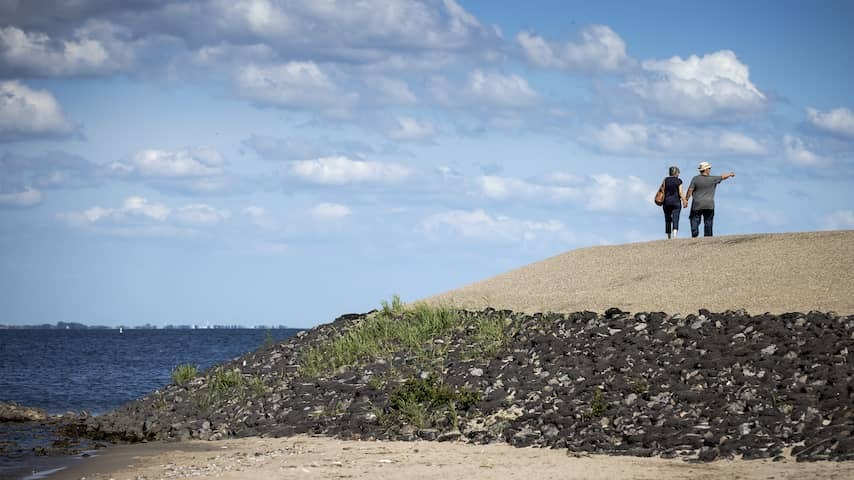
Nederlandse pensioenfondsen hebben hun vermogen de afgelopen maanden zien toenemen, ondanks de onrust op financiële markten en het geweld in het Midden-Oosten. Dat blijkt uit cijfers die vijf grote fondsen donderdag publiceren. De toename kan goed nieuws zijn voor pensioenen.
Een eventuele verhoging van de pensioenen hangt nauw samen met de dekkingsgraad. Die geeft aan hoe goed een fonds ervoor staat. Bij alle vijf de fondsen is de dekkingsgraad gestegen.
Zo is bij ambtenarenfonds ABP, het grootste pensioenfonds van Nederland, de dekkingsgraad bijna 6 procentpunt hoger dan aan het begin van het jaar. Bij zorgfonds PFZW en metaalfonds PME was de stijging zelfs nog wat groter.
Dat de fondsen er beter voor staan, komt onder meer doordat ze hun vermogens zagen groeien. Zo deden de aandelenkoersen in de Verenigde Staten het uiteindelijk redelijk goed, ondanks de onrust van begin april. Toen kwam de Amerikaanse president Donald Trump met zijn importheffingen.
“Aanvankelijk beloofde het tweede kwartaal economisch onrustig te verlopen”, stelt bestuursvoorzitter Joanne Kellerman van PFZW. “President Trump zorgde voor onvoorspelbare handelspolitiek, wat leidde tot turbulentie op de financiële markten. Daarna dwarrelde het stof – in ieder geval voorlopig – weer vrij snel neer.”
Dalende dollar speelt rol bij Amerikaanse beleggingen van fondsen
De stijgende vermogens zijn goed nieuws voor de fondsen. Dat geldt zeker nadat ze in het eerste kwartaal van dit jaar nog verliezen hadden moeten incasseren.
Wel hadden de fondsen bij hun Amerikaanse beleggingen last van de dalende dollar. Maar doordat ze dit risico deels afdekken, had die daling niet zo’n grote invloed.
Daarnaast speelde de stijgende rente een rol. Die zorgt ervoor dat de pensioenfondsen nu minder opzij hoeven te zetten om aan toekomstige betalingsverplichtingen te kunnen voldoen.
Fondsen mogen de pensioenen verhogen als de dekkingsgraad dit najaar boven de 110 procent uitkomt. Eind juni zaten de drie eerdergenoemde fondsen, daar allemaal ruim boven. Ook het andere metaalfonds, PMT, en bpfBOUW komen boven die drempel uit, het bouwfonds zelfs ruimschoots.
Goede cijfers zijn geen garantie op pensioenverhoging
Toch zijn de mooie cijfers geen garantie op een verhoging. Zo is die ook afhankelijk van wat er de komende maanden gebeurt met beleggingen en de rente.
Daarnaast zijn sommige pensioenfondsen voorzichtiger, omdat ze de komende tijd over moeten naar een nieuw stelsel (lees daar meer over in onderstaand kader). Dat is een zeer ingewikkelde klus, waarvoor de fondsen soms extra financiële ruimte voor willen inbouwen.
Zo heeft PFZW al aangegeven terughoudend te zijn met verhogen, omdat het fonds eind dit jaar overgaat naar het nieuwe stelsel. “We willen zeker weten dat we op 1 januari 2026 een gezonde financiële positie hebben om zo voor al onze deelnemers evenwichtig de overstap te kunnen maken naar de nieuwe pensioenregeling”, schrijft PFZW op zijn site.
Dutch pension funds have seen their assets increase in recent months, despite the unrest in financial markets and the violence in the Middle East. This is evident from figures published by five major funds on Thursday. The increase may be good news for pensions.
Any increase in pensions is closely related to the funding ratio. This indicates how well a fund is doing. The funding ratio has increased for all five funds.
For example, at civil servants’ fund ABP, the largest pension fund in the Netherlands, the funding ratio is almost 6 percentage points higher than at the beginning of the year. At healthcare fund PFZW and metal fund PME, the increase was even slightly larger.
The fact that the funds are doing better is partly because they have seen their assets grow. For example, stock prices in the United States ultimately did reasonably well, despite the unrest at the beginning of April. That was when US President Donald Trump came up with his import duties.
“Initially, the second quarter promised to be economically turbulent,” says chairman Joanne Kellerman of PFZW. “President Trump caused unpredictable trade policies, which led to turbulence in the financial markets. After that, the dust settled – at least for the time being – fairly quickly.”
Falling dollar plays a role in US investments by funds
The rising assets are good news for the funds. This is certainly the case after they had to accept losses in the first quarter of this year.
However, the funds suffered from the falling dollar in their US investments. But because they partially hedge this risk, the fall did not have such a major impact.
In addition, rising interest rates played a role. This ensures that pension funds now have to set aside less to meet future payment obligations.
Funds may increase pensions if the funding ratio exceeds 110 percent this fall. At the end of June, the three aforementioned funds were all well above that. The other metal fund, PMT, and bpfBOUW also exceed that threshold, with the construction fund even well above it.
Good figures are no guarantee of a pension increase
However, the good figures are no guarantee of an increase. This also depends on what happens to investments and interest rates in the coming months.
In addition, some pension funds are more cautious because they will have to switch to a new system in the near future (read more about this in the box below). This is a very complicated task, for which the funds sometimes want to build in extra financial space.
For example, PFZW has already indicated that it will be cautious about increasing because the fund will switch to the new system at the end of this year. “We want to be sure that we have a healthy financial position on January 1, 2026 in order to be able to make the transition to the new pension scheme in a balanced way for all our participants,” writes PFZW on its site.